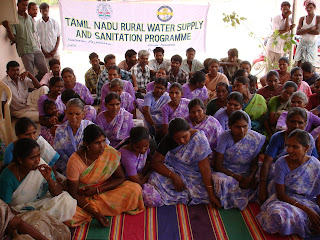After the day in Delhi, Santiago Arconada, Dr. Suresh and I went to Bangalore, the booming IT capital of India. We immediate notice one of the side-effects of the rapid economic growth of the last five years: the air is thick with exhaust fumes from the countless cars and motorbikes that fill the streets of Bangalore, a city traditionally known for its calmness, lush gardens and ample trees and flowers.
In the course of the day we discover that Bangalore - and the state of Karnataka more generally - is a major hotspot of water privatisation in India. Earlier this decade, global water giant Suez had its eyes set on Bangalore, but a full-scale transfer of water delivery to the private sector was avoided, in part due to trade union opposition. Veolia and Northumbria were involved in a privatisation ‘pilot project’ covering parts of the city, but the contract was terminated after the private firms failed to deliver the promised results. After this failed experiment, Bangalore has experienced a process of piecemeal privatisation: one essential task after the other has been sub-contracted to private operators; Thames Water, for instance, has a contract for leakage detection. Local activists argue that this means that the city’s water supply is practically 90% privatised. And now there is the Greater Bangalore Water Supply and Sanitation Project (GBWASP), which may also contract out the central task of water distribution. The project is promoted by USAID, the World Bank and its International Finance Corporation (IFC), the latter coordinates the process of bringing in an (international) private water operator. Strong opposition from within the Bangalore Water Supply Board as well as from community groups and activists has delayed a final decision on this most controversial aspect. If it goes ahead, it would mean that only bulk water supply is left under public management; water to Bangalore is pumped in from a source some 100 kilometres away.
In the evening we participat e in a very vibrant public debate hosted by the Campaign Against Water Privatisation (CAWP), the coalition that has over the last three years resisted the proposed privatisation in Bangalore. We were welcomed by fabulous drumming and singing by musicians from the Dalit community (the heavily discriminated cast referred to as untouchables). Half of the more than 100 people in the audience are slum dwellers, we’re told. An estimated 20% of Bangalore’s 2,2 million inhabitants live in slums. It is exactly for those living in slums and other poor areas that the proposed privatisation has little or nothing to offer. Quite contrary, there are fears that privatisation may result in closing of the thousands of public fountains on which the poorest in Bangalore depend.
e in a very vibrant public debate hosted by the Campaign Against Water Privatisation (CAWP), the coalition that has over the last three years resisted the proposed privatisation in Bangalore. We were welcomed by fabulous drumming and singing by musicians from the Dalit community (the heavily discriminated cast referred to as untouchables). Half of the more than 100 people in the audience are slum dwellers, we’re told. An estimated 20% of Bangalore’s 2,2 million inhabitants live in slums. It is exactly for those living in slums and other poor areas that the proposed privatisation has little or nothing to offer. Quite contrary, there are fears that privatisation may result in closing of the thousands of public fountains on which the poorest in Bangalore depend.
During our visit to Bangalore we also learn about the advanced plans for privatising water distribution in three cities in North Karnataka. A subsidiary of French water giant Veolia has good chances of capturing the contract for these ‘pilot projects’. The background of the privatisation in these cities is that water supply in these cities has virtually collapsed. As part of a World Bank driven reform scheme, Karnataka’s state water company was ‘decentralised’ in a way that seems to have seriously weakened public service capacity in the state. The same has happened in numerous other states across India.
We leave Bangalore with the worrying sense that a new wave of privatisation is underway in India, with Karnataka as the focus of experiments by international financial institutions with new formats for handing over water supply to private firms, without expecting them to invest and with public funds safeguarding their returns.









